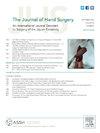形状改良前臂桡侧皮瓣的尸体解剖研究。
IF 2.1
2区 医学
Q2 ORTHOPEDICS
引用次数: 0
摘要
目的:Mateev开发了一种形状改良的桡骨前臂皮瓣(SMRFF),其应用并不广泛。本研究旨在分析手部亚单位缺陷及其组合,并利用SMRFF进行重建。方法:对10具注射尸体进行解剖研究,探讨SMRFF可达的亚基和组合。记录桡动脉蒂长度、桡动脉穿支的数量和位置、皮瓣的尺寸和表面积、皮桨的数量、尺寸和表面积。结果:10具尸体的背侧、掌侧、掌侧亚基的所有组合以及第一蹼空间的两侧均可覆盖。两个背侧近端指骨只有相邻时才能被覆盖。桡骨蒂平均长度为19.3 cm。所有穿支(直径> ~ 0.5 mm)均为中隔皮,每条动脉3 ~ 9支(平均6.3支)。平均而言,前臂近三分之一处有2个穿支,中间三分之一处有2.3个,远三分之一处有2个。在前臂近三分之一处,外上髁与穿支之间的平均距离为6.6 cm。在前臂的中间三分之一处,这个距离是11.8 cm。在前臂远端三分之一处,穿支与桡骨茎突之间的平均距离为4.3 cm。皮瓣平均表面积为98.4 cm2,其中近端桨叶34.4 cm2,中端桨叶28.2 cm2,远端桨叶22.8 cm2。结论:SMRFF可以有效地到达各种手部亚单位缺陷,提供掌部和背部区域的广泛覆盖,并具有详细的穿支和皮瓣测量。临床意义:本研究探讨了SMRFF的解剖学可行性,并证明了其适应性,使其成为手部手术中潜在的有价值的工具。本文章由计算机程序翻译,如有差异,请以英文原文为准。
A Cadaveric Anatomy Study of the Shape-Modified Radial Forearm Flap
Purpose
Mateev developed a shape-modified radial forearm flap (SMRFF), the use of which is not widespread. This study aimed to analyze hand subunit defects and combinations thereof that can be reconstructed using the SMRFF.
Methods
An anatomical study of 10 injected cadavers was conducted to investigate the subunits and combinations reachable with SMRFF. The radial pedicle length, the number and locations of radial artery perforators, the skin flap’s dimensions and surface area, and the number, dimension, and surface area of skin paddles were recorded.
Results
In all 10 cadavers, the dorsum, the palm, all combinations of palmar subunits, and both sides of the first webspace could be covered. Two dorsal proximal phalanges could be covered only when adjacent. The mean radial pedicle length was 19.3 cm. All perforators (diameter > 0.5 mm) were septocutaneous, ranging from 3 to 9 per artery (mean: 6.3). On average, there were two perforators in the proximal third of the forearm, 2.3 in the middle third, and two in the distal third. At the proximal third of the forearm, the mean distance between the lateral epicondyle and the perforator was 6.6 cm. At the middle third of the forearm, this distance was 11.8 cm. At the distal third of the forearm, the mean distance between the perforator and the radial styloid process was 4.3 cm. The mean flap surface area was 98.4 cm2, with 34.4 cm2 for proximal paddles, 28.2 cm2 for middle paddles, and 22.8 cm2 for distal paddles.
Conclusions
The SMRFF can effectively reach various hand subunit defects, offering versatile coverage for palmar and dorsal regions, with detailed perforator and flaps measurements.
Clinical relevance
This study investigates the anatomical feasibility of the SMRFF and demonstrates its adaptability, making it a potentially valuable tool in hand surgery.
求助全文
通过发布文献求助,成功后即可免费获取论文全文。
去求助
来源期刊
CiteScore
3.20
自引率
10.50%
发文量
402
审稿时长
12 weeks
期刊介绍:
The Journal of Hand Surgery publishes original, peer-reviewed articles related to the pathophysiology, diagnosis, and treatment of diseases and conditions of the upper extremity; these include both clinical and basic science studies, along with case reports. Special features include Review Articles (including Current Concepts and The Hand Surgery Landscape), Reviews of Books and Media, and Letters to the Editor.

 求助内容:
求助内容: 应助结果提醒方式:
应助结果提醒方式:


